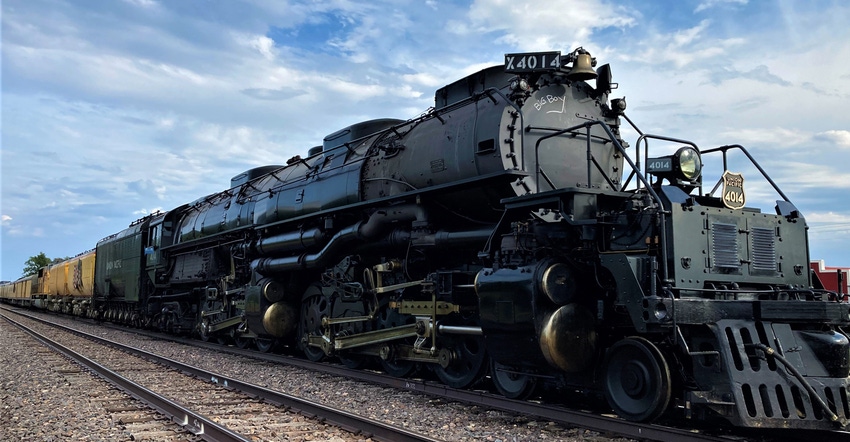September 17, 2021

If you wait long enough, history will circle back and repeat itself. The only thing that changes is how we respond.
I pondered this on the drive last week to Hays, Kan., to see Union Pacific’s Big Boy 4014 on one of its stops across the country.
You see, the original fleet of 25 Big Boy steam engines was commissioned by Union Pacific to fix a transportation bottleneck it had in eastern Utah in the late 1930s. The Wasatch Mountains have a steep slope that rises 1,900 feet in elevation over just 55 miles or so. It was impossible to get a fully loaded 3,600-ton freight train up and over the mountains with the train engines of the day.
And so, a freight bottleneck built up on the UP railroad line, with loads waiting their turn to get over the mountains. That was an inconvenience, but when the U.S. entered World War II in 1941, that bottleneck became a hindrance to the war effort. Hence, the need for the world’s largest steam locomotive — 600 tons of steel and ingenuity.
A freight bottleneck — gee, that sounds familiar.
Bottlenecks
We heard from the manufacturing and technology sectors during the 2021 Kansas Governor’s Summit on Agricultural Growth that transportation of materials and components is seeing its own bottleneck today. But unlike in the past, where we were waiting on the technology of the day to catch up, today we’re waiting on labor.
Labor shortages have been an issue long before COVID-19, but the pandemic didn’t help the situation. Right now we have job openings in transportation, but few people qualified to fill them. And so, cargo sits, waiting its turn at our ports and in our warehouses before it can get to the manufacturing plants — which are seeing their own labor shortages on their lines — where it will be turned into products for consumers.
You might ask, what this has to do with me on the farm? Well, these bottlenecks in shipping are driving up costs, which are getting passed on to the farmer in the form of shortages, delayed equipment and crop input delivery. In the end, those bottlenecks cost us time and money we can’t afford.
Humans and machines
Consider that the current labor force is aging. The average age in this country of over-the-road truck drivers, pilots and railroad engineers is 60 years. That’s a lot of experience that will be exiting, or has already exited, the workforce. So, simply put, we need more young bodies to go get trained to fill their shoes. Or, we find ways to increase automation.
Humans versus autonomous technology — it’s a delicate balance in the economy. And the longer we have job openings that remain unfilled, the quicker we tip toward automation, reducing the number of hourly skilled job openings altogether. Case in point: Trucking companies aren’t waiting around for drivers to come to them.
They’re turning to autonomous rigs instead.
A segment on “60 Minutes” in August showed how artificial intelligence is coming to the trucking industry in the form of autonomous trucks. The technology is there, and is scalable; it’s just a little cost-prohibitive at this point for mass introduction.
Some autonomous trucks are in operation today, with human tenders still sitting at the wheel as safety checks. So the technology is advancing fast. There will come a time in the not-so-far-off future when big rigs won’t have a human at the wheel, and will be tooling down our nation’s highways delivering our freight.
You might say those autonomous rigs are the Big Boys of their era.
The farmer factor
There’s always going to be pros and cons to all innovations. As I stood next to the massive Big Boy 4014 in Hays, I thought about how many jobs were eliminated with this one engine.
Now, it’s not for me to judge if autonomous trucks, or the next innovation in technology, are good or bad. But I do raise this question: What does this mean for our farmers?
Farmers need reliable transportation to get their inputs on time and a reliable way to get their products to market. But there also are many farmers I know whose off-farm jobs are in a semi cab hauling that freight. What happens when we eliminate or drastically change the jobs for many that are bringing income and benefits to the household budget?
Will autonomous trucking raise or lower costs? And will that get passed along to everyone in the chain? Not to mention, how safe is this technology at high speeds on our rural highways?
I wonder if those were some of the same questions raised when the Big Boy engines were put in place. I also wonder what “innovative” piece of equipment that we use today will draw future families to marvel and gawk.
You May Also Like




